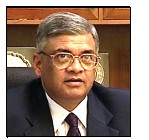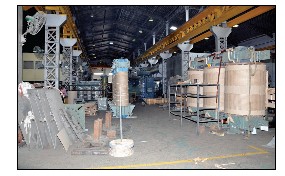 — Anil Aggarwal,
CMD, PME Power Solutions (India) Ltd
PME Power Solutions (India)
— Anil Aggarwal,
CMD, PME Power Solutions (India) Ltd
PME Power Solutions (India) is a leading manufacturer of
distribution transformers with a capacity of 3,600 MVA that is being
ramped up to 7,000 MVA. PME has a clear focus on the overseas
market, with around 75 per cent of its revenues coming from South
African markets. Electrical Monitor caught up with
Anil Aggarwal
during his recent visit to Mumbai. In a freewheeling conversation
with
Venugopal Pillai and Dhairya Ingle, Aggarwal spoke at length
on a broad spectrum of subjects related to his company and to the
power T&D industry in general. Excerpts.
India is in amidst of adding a lot of power generation capacity
and that every MW of generation will need 7 MVA of transformer
capacity. How do you see the demand of transformers?
Yes, according to the XII Five Year Plan, we will create 100,000
mw, which means one will need 8-9 lakh MVA transformation
capacity. Besides this, the transformers installed in the VII Five
Year Plan will have to be reinstalled or replaced because by the
time we are in the XII Plan, the old transformers would have
outlived their capacity. Hence, we shall have 1.5 million MVA
transformers to be replaced or installed. Our current (national)
capacity is around 205,000 MVA, out of which 33 per cent is for the
overseas market. Effectively you are left with 165-170,000 MVA.
Hence I see a growth opportunity of 20 per cent. The transformer
industry looks good and will grow at the rate of 15-20 per cent.
With China now entering the Indian market, do you face
competition from the Chinese markets?
China is trying to enter the market, but as of now, has not
created a dent in the industry. The reason for this is their highly
"specification-driven" transformers. In India, making
transformers is a tailor-made exercise. Every customer has his
own specifications even if he is buying a small transformer. This
has been the biggest barrier for foreign players.
Is the country moving ahead in terms of having own standard
specifications of transformers which could help able to achieve
better economies of scale for transformer manufacturers?
Here I would say that rural electrification is playing the role of a
catalyst, since it has joined hands with Central Electricity
Authority in order to improve the quality of transformers. It has
already come up with star labeling policy which is mandatory for
the transformers up to 200kV.
 We see transmission infrastructure moving up from 220kV to
400kV and now we even have 765kV. What impact do you see
this having on the efficiency or power transmission?
We see transmission infrastructure moving up from 220kV to
400kV and now we even have 765kV. What impact do you see
this having on the efficiency or power transmission?
India is a big country. If one has to supply power to every nook
and corner of the country, we need to have a National Grid,
which is exactly the role of Power Grid Corporation of India. In
case, we need to contain the losses we have no option but to
obviously go for a higher capacity. This is exactly what is
happening. In the 1950s, we had capacity of only up to 33kV,
which went to up to 400kV. Hence with modernization and
technology, you will also see 1,200kV coming very soon on the
Indian grid.
Tell us about your capex plans.
We are enhancing our distribution transformer capacity from
3,600 MVA to 7,000 MVA at our Noida plant. This a

85-crore
project to be funded internally. The project started in December
2010 and is likely to get commissioned by December this year.
We have also planned to start manufacturing high-rating
transformers of 400kV next year.
What has been your domestic-international business mix?
Around 75 per cent of our revenues come from the overseas markets, mainly South Africa. We will this 75:25 business mix
continuing for at least three more years. International markets
are receptive to PME products are they have wide acceptance
too. The domestic market is flooded by number of players thus
has a lot of competition.
Due to our focus on the international business, our total
turnover has jumped from

203 crore in 2003 to

434 crore this
year. We find the South African market more challenging as
compared to any other market. Also that South Africa has a rich
source of mineral resources.
Tell us about PME's South African connection.
Let me begin with a background. PME Power Solutions was
started in 1986 with an objective of manufacturing distribution
transformers. In 1990, we went in for power transformers up to
33kV. Towards the end of the 1990s, we began manufacturing
bigger power transformers up to 66kV. In 2003, we entered the
132kV range.

The biggest development in our corporate history, which
marked a turnaround for PME, was an overseas deal with South
Africa. Although we were exporting transformers since 1994,
our international business was small. In January 2006, we
entered into a five-year technology transfer agreement with a
Zimbabwe power utility that wanted to manufacture
transformers in Harare. The five-year agreement was renewed
last year for an equal period ahead. This took us closer to the
South African markets. Once we were in Zimbabwe, we started
looking at neighbouring nations that form what is known as the
"SADEC" (South African Development Community) region,
comprising Zambia, Namibia, Angola, etc. Once we had our
transformer business in place, we entered in the T&D business,
mainly building substations in South African nations.
Do you find a change in terms of procurement of terms and
policies from the electricity boards?
Now the number of clients (distribution utilities) has increased.
Initially it was one state utility, now it could be four or even five
in a state. There is no change in procurement policies; it is the
same as earlier.
Do you see ATC losses going down after the unbundling of state
electricity boards?
Losses have gone down but not to a great extent. However, the
overall achievements are far better than before. Further,
accountability has increased due to trifurcation. But the real
game lies when the entire (distribution) sector is controlled by
the private sector.
How do you see the government's success rate in privatizing
distribution circles?
It is a very slow process; it cannot happen overnight even if the
government wants it to do. They have come out with Energy
Conservation Act, New Indian Electricity Act, so the sector
needs to be a little more open. A lot of IPPs (independent power
producers) have come up. If you see the XII Plan, 50 per cent of
the power comes from private sector. So it is not that people are not taking interest. A lot of private entities have gone in for
private trading also. So this is a slow process.
Do you think political will has anything to do with the rate of
privatization of power distribution?
Let us not define it as political will. We must realize that power
is the most capital intensive area. Secondly, we do not have a
system where decisions are taken by a single person. Let us
consider the power ministry-there are bureaucrats, there is
Planning Commission then there are states, which in fact have
to go for reforms. Each state has different political set up. So in
situations like these delays are bound to happen. We have an old
adage in business, "You can assign two jobs to one person but
never one job to two persons!" So it is not something like will is
not there. We have very intelligent people but when it comes to
decision making and delivery, the system is so lengthy and also
conservative.
As I said, we must appreciate that the power sector is the
most capital intensive area. If you talk of electrifying India by
2025 you need 8 lakh mw of power
capacity. Imagine the amount of money
required in the next 14 years!
Do you think going forward the concerns
of fuel would get stronger?
All the natural resources are scarce.
You don't have land. If you cater the
manufacturing sector for exports,
we do not have roads, no ports, and
no electricity. A lot of work has still to
be done.
Coming back to your business, you had
plans to make dry-type transformers.
Yes, we had plans and also the
technology. However we haven't done
much in this area because our
technology is extremely different. We
are not going into normal dry
encapsulated transformers. What we
are doing is vacuum impregnation
technology with classic PM&F insulation,
which is not very popular in India. People
still go for epoxy. And, our major market Kenya does not face
problem of space.
But we hear of Kenya planning to use dry type transformers to
prevent vandalism of oil-filled transformers.
Yes, they had thought about it but did not go for it. Even we
believed that oil transformers for Kenya was now a story of
past! However, matters are back to oil-filled transformers.
 What is your take on cheap CRGO entering India, allegedly from
Chinese suppliers?
What is your take on cheap CRGO entering India, allegedly from
Chinese suppliers?
Let us first understand that inferior quality CRGO is not coming
from China. And speaking about CRGO, we (India) has never
faced a shortage. The reason we keep hearing about CRGO
shortage is because it is not produced in India. Select
companies in UK, USA, France and Japan are the major
manufacturers.
We hear that PME was to diversify into energy-efficient lighting
systems.
It is still at the planning stage. Nothing concrete has been done
yet. We are undertaking R&D projects in this field.
Do you have plans to emerge as a developer in the generation or
transmission area?
No, we do not have any plans to venture into power
development. As on date, we are happy with the way we are
moving. Our area of growth is transmission and distribution
sector where we would like to continue.
We hear of skilled manpower constraints in the power sector.
Being in this industry for last 33 years, I have never come across
such constraints. Of course, I do not disagree that there is a
shortage of manpower, but you need to create people. We have
had people at PME working for several
years. This has helped us and the
company to grow.
What do you attribute your company's
phenomenal growth to?
The credit goes to all my workers and staff
who have put in untiring efforts. The
average age of employment in my company
is more than 15 years. We do not believe in
hiring and firing. We have nurtured people
and haven't penalized them for their
mistakes. On the contrary, we have trained
them to suit the company's needs.
Currently, I think we are the best one of the
best pay masters in the industry!
What corporate goals would you like to
attain?
A company that gives a complete value for
money, complete satisfaction, employee
growth and become a self-sustaining
company, in next 3-4 years. We also aim
to create wealth for our investors.